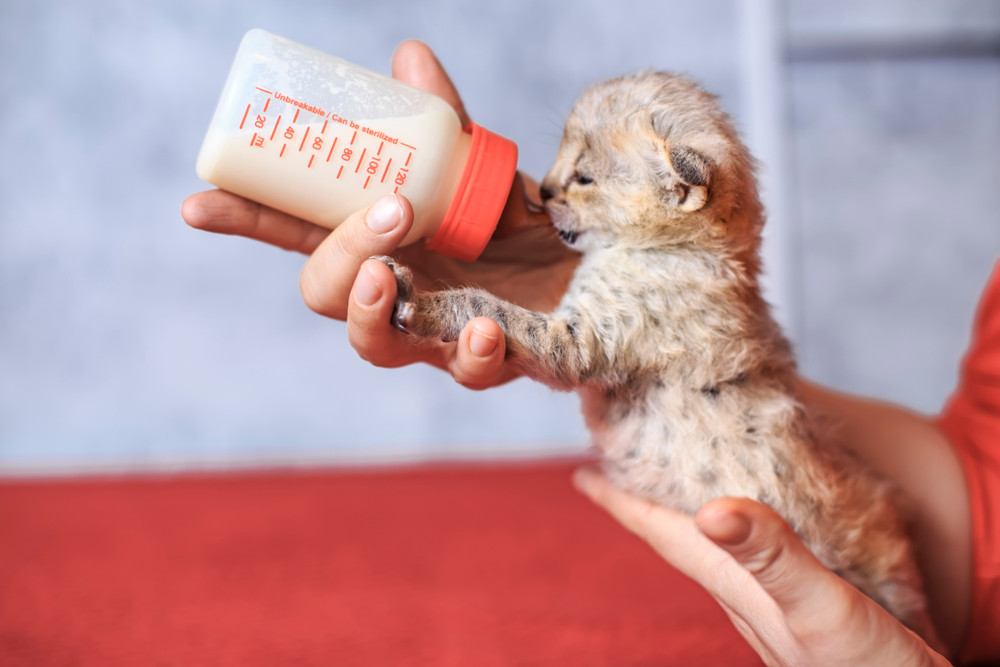Kittens, with their adorable antics and boundless energy, often bring immense joy into our lives. However, they can also exhibit certain behaviors that might leave us puzzled. One such behavior is the urge to suckle, even when they are no longer dependent on their mother’s milk. This is where the concept of a Cat Pacifier comes in. While not as commonly discussed as baby pacifiers, kitten pacifiers can be a useful tool in specific situations.
Typically, kittens don’t instinctively require pacifiers. Yet, for some felines, especially those separated from their mothers prematurely, a pacifier can offer significant comfort. You might notice these very young kittens persistently suckling on their milk bottles long after they’re empty or seeking solace in sucking on their bedding.
Neither of these scenarios is ideal. Constantly holding a bottle for a kitten isn’t always feasible, and damp bedding isn’t hygienic. Bedding can harbor dirt and germs, posing a health risk if kittens are continually sucking on it.
DIY kitten pacifiers present a practical solution. They are simple to create at home using readily available materials. Below, we’ll explore when a kitten might benefit from a pacifier and guide you through easy steps to make your own.
 divider cat paws 2 oct 2024
divider cat paws 2 oct 2024
When Might a Kitten Need a Pacifier?
Adopting a kitten doesn’t automatically mean you’ll need a pacifier. Many kittens thrive without one and might not even use one if offered. In most standard adoption cases, pacifiers aren’t a necessity.
However, certain circumstances can make a pacifier beneficial for your kitten:
Very Young Kittens
Ideally, very young kittens should remain with their mothers. Unfortunately, this isn’t always possible. Situations like the mother’s passing or unethical breeding practices that separate kittens early can occur. In these instances, a kitten pacifier can be invaluable. Kittens have an inherent need to suckle, which provides comfort and security. If this need isn’t met, they can become noticeably distressed. A pacifier can mimic the soothing action of nursing, helping to alleviate anxiety and provide a sense of calm.
Kittens Experiencing Stress
Suckling can be a source of comfort for kittens in stressful situations, regardless of their age. Illness, for example, is a significant stressor for felines, and stress can hinder recovery. Reducing stress levels is crucial, and a pacifier might be a helpful tool in achieving this. The familiar action of suckling can have a calming effect, potentially aiding in a smoother recovery process. Introducing a pacifier in stressful times can offer a non-invasive way to soothe and comfort your kitten.
Teething Kittens
Teething is a significant event for kittens, much like it is for human babies. Kittens develop their “milk teeth” as early as 2 weeks old. Around 10 weeks of age, their adult teeth start to emerge, causing discomfort and sometimes pain. While there aren’t many direct remedies for teething pain in kittens, a pacifier could be a helpful option to try. The gentle pressure and sucking motion might provide some relief to their gums. If you opt for a pacifier for a teething kitten, carefully consider the material and continuously monitor your kitten and the pacifier’s condition to prevent ingestion of any parts.
Kittens with Weaning Difficulties
Usually, kittens wean from their mothers naturally, with the mother cat initiating the process. Human intervention is rarely needed. However, there are instances where kittens might need extra support, especially if the mother isn’t actively encouraging weaning. In such cases, a pacifier can be a useful aid. Older kittens that are still suckling might be doing so more for comfort than nutritional needs. A pacifier can act as a substitute for the mother, assisting in the weaning transition. Weaning off the pacifier itself can be addressed later and might be easier once the association with feeding has been disrupted.
 divider cat paws 2 oct 2024
divider cat paws 2 oct 2024
DIY Kitten Pacifier: Two Simple Methods
In any of the situations mentioned above, providing a pacifier can be beneficial for your kitten’s well-being. Making a kitten pacifier at home is often simpler and more convenient than searching for commercial alternatives, which are not widely available. Here are two easy DIY methods:
Option One: Repurposing a Baby Pacifier
This method involves adapting a standard baby pacifier to create a comforting soother for your kitten.
Step 1: Get a Baby Pacifier
 Baby blue pacifier
Baby blue pacifier
Image Credit: Baby blue pacifier for kittens, Shutterstock
Begin by purchasing a baby pacifier. Opt for the smallest size available, as kitten mouths are considerably smaller than those of babies. While numerous styles are available, the specific type isn’t overly critical.
However, latex pacifiers are generally recommended due to their softer texture, which kittens are more likely to accept. Silicone pacifiers are also a viable alternative and work well for many kittens. Avoid hard plastic pacifiers, as these can be too rigid and potentially harm a kitten’s sensitive gums.
You can reuse pacifiers that have been previously used by human babies or other kittens, provided they are thoroughly sanitized. Proper sanitization is essential to eliminate any residual scents that might deter your kitten from using the pacifier. You want to ensure it doesn’t smell like a baby, which could be off-putting to your kitten.
Step 2: Choose a Familiar Comfort Item
Most kittens won’t automatically take to a plain baby pacifier. They won’t associate it with comfort, and unlike with a baby, you can’t easily place it in their mouth. Therefore, it’s vital to pair the pacifier with something your kitten already finds comforting.
Bedding, a soft blanket, or a familiar stuffed toy are excellent choices. If your kitten has already been observed suckling on a particular item, consider using that. Plush toys can also work well, especially if they are already familiar to your kitten. The goal is to combine the pacifier with a known comfort object, not introduce something entirely new at the same time.
The comfort item should be large enough for the kitten to snuggle against, similar to how they would cuddle with their mother. However, it should also be small enough to be easily portable. A human-sized pillow, for example, would be too large and impractical.
You might consider cutting a blanket or pillowcase to achieve the right size for your kitten pacifier.
Step 3: Attach the Pacifier to the Comfort Object
Next, securely attach the pacifier to the chosen comfort object using a sturdy string or thread. The pacifier should be attached as closely as possible to the item. The aim is to make it seem like the pacifier is an inherent part of the comfort object, making it more appealing for suckling.
Ensure any excess string is trimmed to prevent it from becoming a strangulation hazard. The connecting cord should be kept short for safety reasons. You want to eliminate any risk of your kitten getting tangled in the string.
Option Two: Reusing a Kitten Bottle
This method is particularly convenient if you have a very young kitten, as you likely already have kitten feeding bottles on hand.
Step 1: Find a Kitten Bottle
 F1 Kitten drinks milk from a bottle
F1 Kitten drinks milk from a bottle
Image Credit: Kitten drinking milk from bottle, Shutterstock
If you have a young kitten, chances are you already possess kitten feeding bottles. You might still be using these bottles for feeding, or you might have recently weaned your kitten off formula.
This method is most practical for those with younger kittens who are already familiar with bottle feeding and likely have spare bottles.
The first step is to select a bottle that you no longer need for feeding. Once repurposed as a pacifier, it won’t be suitable for feeding again. Therefore, it’s best to choose an older bottle. Kitten bottles are generally inexpensive, so purchasing a new one specifically for this purpose is also an option.
Step 2: Introduce the Empty Bottle
If your kitten isn’t already accustomed to a bottle as a pacifier, you need to introduce it in a positive way. Ideally, start by using a kitten milk replacer that your kitten is already familiar with inside the bottle. If your kitten is already weaned, method one might be more suitable, as this method assumes bottle familiarity.
After your kitten finishes feeding, take the bottle and wash it thoroughly. Then, return the empty, clean bottle to your kitten. It will be empty, but your kitten will already associate it with the action of suckling. Many kittens will naturally continue to suck on the nipple for comfort. This is precisely the desired outcome.
Some kittens will suck on the nipple independently, while others might prefer it propped up in a comfortable position. Observe your kitten’s preference and adjust accordingly.
How to Encourage Your Kitten to Use a Pacifier
Even with these DIY methods, there’s a possibility your kitten might not accept a pacifier. This is perfectly normal, and there’s not much you can do to force it. In fact, if a kitten doesn’t need a pacifier, it’s a positive sign, as suckling is primarily associated with feeding. Pacifiers are best used as a substitute only if your kitten is exhibiting excessive suckling behaviors on fingers, blankets, or other inappropriate items.
Some kittens simply don’t have the need or desire for a pacifier. Just because your kitten was weaned early or seems anxious doesn’t automatically mean a pacifier is necessary, and that’s perfectly fine!
 divider cat paws 2 oct 2024
divider cat paws 2 oct 2024
Final Thoughts
While kittens don’t universally require pacifiers, there are specific situations where they can be incredibly helpful. These situations include early weaning or being separated from their mothers too soon. Commercially available kitten pacifiers are scarce, making DIY options the most practical solution.
You can easily create a kitten pacifier by adapting a baby pacifier or repurposing a kitten bottle. If your kitten is already bottle-fed, the latter option is particularly convenient. However, baby pacifiers can be easier to use due to their smaller size and lower cost compared to kitten bottles.
Regardless of the method you choose, making a kitten pacifier is a straightforward process that takes just a few minutes. It can offer significant comfort and relief to kittens who need that extra bit of soothing in their lives.
Related Reads:
Featured Image Credit: ToKa74, Shutterstock
How useful was this post?
Click on a star to rate (you can leave written feedback after clicking submit)
Help us improve Catster for pet parents!
Your feedback really matters.
What did you like about this post? Also how can we improve it?

